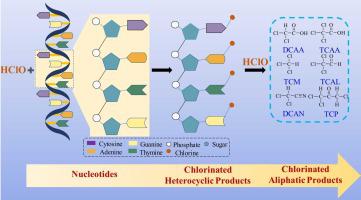Journal of Hazardous Materials ( IF 13.6 ) Pub Date : 2023-03-20 , DOI: 10.1016/j.jhazmat.2023.131242 Guangrong Sun 1 , Han Yeong Kaw 1 , Meijiao Zhou 1 , Pei Guo 1 , Lizhong Zhu 1 , Wei Wang 1

|
Identification of emerging disinfection byproducts (DBPs) of health relevance is important to uncover the health risk of drinking water observed in epidemiology studies. In this study, mutagenic chlorinated nucleotides were proposed as potential DBPs in drinking water, and the formation and transformation pathways of these DBPs in chlorination of nucleotides were carefully investigated. A total of eleven chlorinated nucleotides and analogs were provisionally identified as potential DBPs, such as monochloro uridine/cytidine/adenosine acid and dichloro cytidine acid, and the formation mechanisms involved chlorination, decarbonization, hydrolysis, oxidation and decarboxylation. The active sites of nucleotides that reacted with chlorine were on the aromatic heterocyclic rings of nucleobases, and the carbon among the two nitrogen atoms in the nucleobases tended to be transformed into carboxyl group or be eliminated, further forming ring-opening or reorganization products. Approximately 0.2–4.0 % (mol/mol) of these chlorinated nucleotides and analogs finally decomposed to small-molecule aliphatic DBPs, primarily including haloacetic acids, trichloromethane, and trichloroacetaldehyde. Eight intermediates, particularly chlorinated imino-D-ribose and imino-D-ribose, were tentatively identified in chlorination of uridine. This study provides the first set of preliminary evidence for indicating the promising occurrence of chlorinated nucleotides and analogs as potential toxicological-relevant DBPs after disinfection of drinking water.
中文翻译:

氯化核苷酸和类似物作为饮用水中潜在的消毒副产物
识别新出现的与健康相关的消毒副产物 (DBP) 对于揭示流行病学研究中观察到的饮用水的健康风险非常重要。在这项研究中,诱变氯化核苷酸被提议作为饮用水中的潜在 DBP,并仔细研究了这些 DBP 在核苷酸氯化中的形成和转化途径。一氯尿苷/胞苷/腺苷酸、二氯胞苷酸等11个氯化核苷酸及其类似物被初步鉴定为潜在的DBPs,其形成机制涉及氯化、脱碳、水解、氧化和脱羧。与氯反应的核苷酸的活性位点在核碱基的芳香杂环上,碱基中两个氮原子间的碳原子易转化为羧基或被消去,进一步形成开环或重组产物。大约 0.2–4.0% (mol/mol) 的这些氯化核苷酸和类似物最终分解为小分子脂肪族 DBP,主要包括卤乙酸、三氯甲烷和三氯乙醛。八种中间体,特别是氯化亚氨基-D-核糖和亚氨基-D-核糖在尿苷的氯化反应中被初步鉴定。这项研究提供了第一组初步证据,表明氯化核苷酸和类似物在饮用水消毒后有可能作为潜在的毒理学相关 DBPs 出现。


























 京公网安备 11010802027423号
京公网安备 11010802027423号